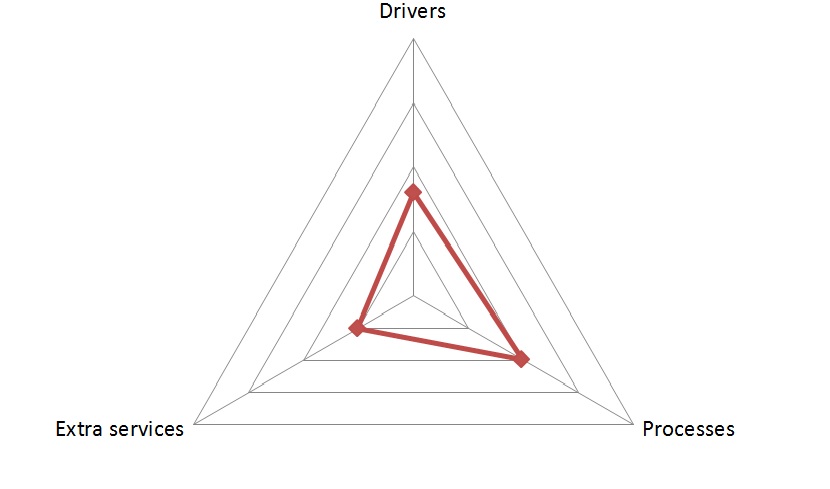“What special things are top airports doing in order to achieve such great satisfaction scores? Is it their shopping? Their staff? Artwork? Sense of place? etc… They must be doing something really different in order to score so much better than us.” I hear this quite a lot from airports seeking to increase passenger satisfaction levels.
So what is this special thing the top performing airports have? The more I travel and work with airports all over the world, the more I believe it comes down to 1 simple word: balance.
In a lot of ways managing the passenger experience in an airport is like mixing a cocktail. All airports have the same set of ingredients to play with (the services and processes which make up the experience) and mix these together to create what is their own passenger experience. And yet some leave passengers with a sweet taste that makes them want to come back for more while others leave you wishing you could throw the whole drink down the drain.
As with cocktails, I believe the quality of the ingredients plays a part but what can really set one airport apart from the rest is how you mix the ingredients together. Too much of one and it makes the whole drink taste bad. In essence, it is the balance of ingredients and how they work together that makes a cocktail truly great. And it’s this balance which is so complicated for many airports to achieve.
Perfect balance
So what does a well-balanced, great airport experience looks like? To illustrate this we first need to simplify things a bit. Globally, airport services can be grouped into three main categories:
- Basics: cleanliness, atmosphere, washrooms
- Processes: check-in, security, wayfinding, baggage delivery, etc…
- Commercial and retail: shopping, restaurants, Wi-Fi, lounges, etc…
If you take the average satisfaction scores for all service aspects which make up the passenger experience at an airport and group them by category you get a picture of what the airport’s service balance is like, showing on which of the three areas the airport is focusing most of its efforts and getting its highest satisfaction scores.
And that’s where it gets interesting: the world’s best airports all have exactly the same profile:
So while all of the best airports are indeed unique, they have in common that every single one of them has set the same order of priority:
#1: the basics
#2: key processes
#3: commercial services
Why do they do this?
What the best airports have understood is that you can’t and needn’t excel in all aspects of the airport experience. Rather they prioritize their efforts and limited resources according to the impact that each service has on the passenger experience.
First of all they make sure they focus most of their efforts on the basic drivers of passenger satisfaction: cleanliness, atmosphere, washrooms. This is what matters most to passengers and so you get your biggest bang for your buck in terms of improving passenger satisfaction levels when you focus here first.
As a second priority they focus on processes. Passengers want to get through an airport quickly and efficiently. But there is no point in achieving your best results in this area and so all of the best airports follow the 80/20 rule and score globally lower for their processes than for the basics.
Why? Simply because airport processes are what we call dissatisfiers. That means that when passengers are very unhappy with the processes they tend to be unhappy with the airport overall. But passengers who are very happy with the processes don’t get any happier with the airport. So the trick is managing your processes so you are performing well enough in order not to cause any stress to your passengers but without wasting energy in performing better than necessary because it won’t help your overall satisfaction levels rise any higher. Or in other words it is better to perform well in these areas all of the time than to excel some of the time.
Finally, the best airports leave additional services until last in their order of priority. This is interesting because quite often people think that it is these special things that set the best apart from the rest. While that can be true, the top airports have understood that they will only reap the benefits of these special services if their basics and processes are well managed. These differentiating services will only work well when the rest of the airport experience is great. In other words, having the best shopping in the world will not help a passenger forget dirty washrooms or a monster queue at security. But when your basics and processes are well managed it will help set your airport apart from the rest.
An unbalanced experience
Now that we’ve seen what the ideal airport experience looks like, it’s interesting to contrast that with the profile of an average airport:
Whereas the best airports achieve a fairly balanced profile, average airports tend to lean heavily towards processes. That’s because most airports achieving average scores still view their job priority to be getting passengers through the facilities as quickly as possible. And so the operations team gets the final say in most key decisions and this tends to be where the airport excels.
Don’t get me wrong, performing well for processes is good and in some cases it is necessary to focus most efforts there (such as when the airport is operating near capacity) but it is important to understand that if the best thing about your airport is a queue it will be very hard for you to achieve top satisfaction levels.
Remember, queues are dissatisfiers and passengers who are very happy with them don’t really get any happier with the airport. You are much better off spending less effort on improving processes and focus more on the basic drivers of satisfaction and then on differentiating your experience through additional services.
Similarly airports that focus on commercial services first don’t perform that well either. When the commercial team gets the final say in decisions that impact the passenger experience you start seeing things such as having too few seats in the gate areas, advertising that overshadows key signage, etc… And passengers resent that as well.
These airports have got the equation the wrong way around. Instead of trying to force passengers who are trapped into the airport to shop they would be better off realising that your commercial offering will have the highest impact when passengers feel that you have addressed their basic needs first and that your processes are stress-free putting them into the mood to shop.
Want greater balance at your airport?
What sets the world’s best airports apart from the rest is not just all the fun, different and cool things they do but how they are able to achieve a greater balance in their service delivery.
How do they achieve this balance? By prioritizing their efforts according to what matters most to their passengers and following some simple principles:
So if you want to improve satisfaction levels at your airport you need to start by looking at how balanced your service delivery is.
Want to know how well balanced your service delivery is? Let us know and we can show you.






